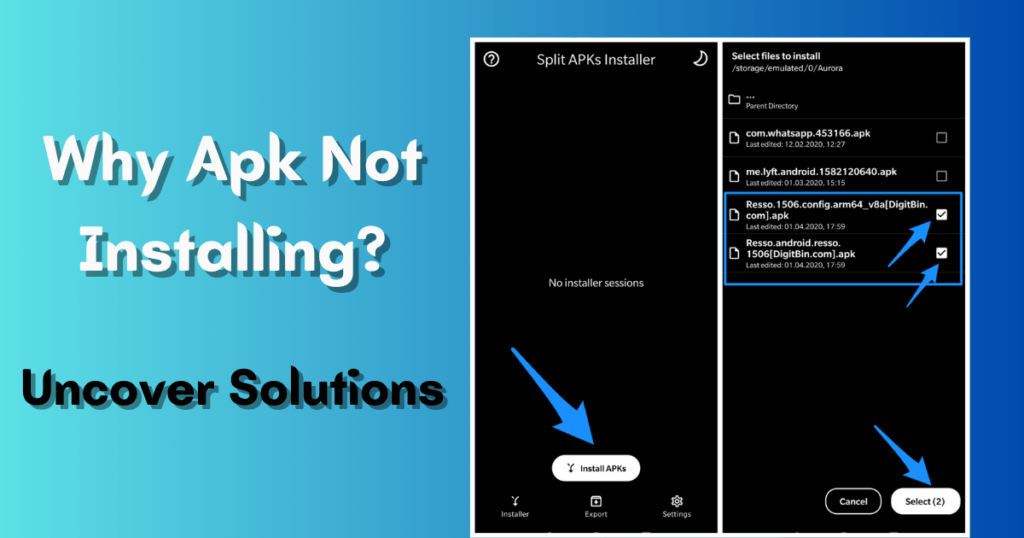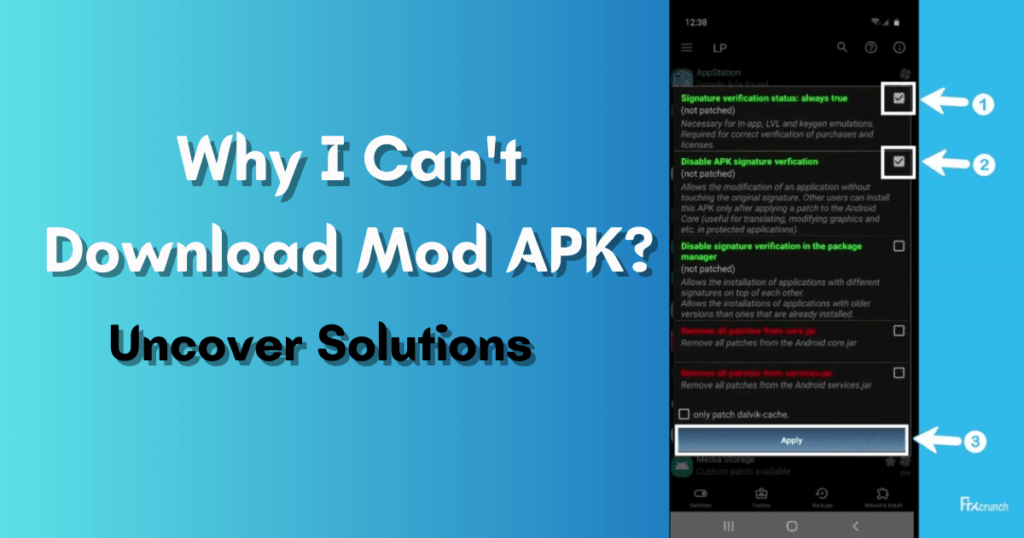An APK not installing if it has a compatibility, storage, or file issue. A lack of permission or a bad download can also block installation.
You must understand why an APK isn’t installed. This happens if there is an issue with compatibility, storage, or the APK file. A lack of permission or a lousy download can also block installation. This is crucial for fixing the problem quickly. You need it on your device.
We’ll uncover the challenges users face. They happen when you install these Android app files. Smartphone usage continues to soar. Fixing these issues is essential. It keeps an excellent mobile experience.
Updating your device’s software helps. So does having enough storage space. These steps often ease installation problems. Getting APKs from good sources is essential. It cuts the risk of harmful files. It also reduces compatibility issues. Let’s explore how you can solve the APK Not Installing issue.

Troubleshooting APK not installing issues
Fixing APK not installing issues can be baffling. They happen when an Android app refuses to install. Users face various errors that hinder the installation process. Knowing the common problems and the proper steps can often fix them fast. This section covers common APK installation challenges. It also gives the first steps for a smooth app experience.
Common Installation Problems
Several factors cause installation failures. This happens when dealing with APK files. Users may see error messages. Or the installation might stall. Common culprits include:
- Incompatible app versions
- Insufficient storage space
- Corrupt or incomplete APK files
- Improper app permissions
- Installation from unknown sources is not enabled
Initial Steps to Resolve
Start with simple fixes. They will tackle APK not installing problems.
- Restart your device. This will clear any temporary glitches.
- Check your network connection. Bad connections can disrupt downloads.
- Ensure that ample storage space is available for the new app.
- Verify the APK file isn’t corrupt and download it again if needed.
- Confirm that you’ve permission to install from unknown sources.
In most cases, these steps fix the problem. They let the application install smoothly. Still, if the problem continues, you may need to inspect it more closely. Resolve the APK. Don’t add hurdles. Be patient and ensure a smooth app installation.
File Integrity and Compatibility
Have you ever tried installing an APK file and found it wouldn’t work? It’s frustrating. However, the issue is often the APK file’s health or whether it fits your device. Let’s dive into why these factors are crucial.
Checking APK File Health
An APK file might be incomplete or damaged. This means the app won’t install correctly. Here are ways to ensure the APK file is in good shape:
- Use a reliable source: Always download APKs from trusted websites.
- Compare the file: size with the one on the download page.
- Scan for viruses: Use an antivirus app to scan the APK before installation.
Ensuring Device Compatibility
Your device must meet the app’s requirements. If it doesn’t, the APK won’t install. Ensure compatibility by:
- Checking the Android version: Some apps need newer versions of Android.
- Reviewing app requirements: Look at the app’s details for its specific needs.
- Understanding your device’s specs: know your device’s CPU type. Also, know its RAM.
Storage and Permissions
Are you having issues with APKs not installing on your device? Often, the problem is in your phone’s ‘Storage and Permissions‘ settings. This part of your device’s setup is crucial. It’s key to installing any app.
Freeing Up Space
To ensure a smooth installation. Start by checking the device’s storage. More space can lead to installation failures. Here are some quick tips:
- Delete unused apps to clear memory.
- Remove old photos, videos, or downloads.
- Use cloud services to move files off the device.
- Clear the cache of other apps to free up some space.
| Action | Result |
|---|---|
| Clean junk files | More space for new apps |
| Uninstall updates | Reclaims space taken by bloated apps |
Note: Check your device storage by going to “Settings” > “Storage.“
Adjusting App Permissions
APK files need proper permissions. Without them, the files can’t be installed. Follow these steps to adjust app permissions:
- Go to ‘Settings’ > ‘Apps’.
- Select the app using the APK file.
- Tap ‘Permissions‘.
- Enable the necessary permissions.
Permissions may include access to storage. They may also include the camera or contacts. Each app requires different permissions. Review the permissions you’ve given. Make sure they won’t harm your privacy and security.
Software Conflicts and Security
Need help to install an APK on your Android device? Software conflicts and security can block installation. Let’s delve into the reasons and solutions.
Identifying Conflicting Apps
Conflicting apps can prevent a smooth installation. It often occurs when an app similar to the one you’re trying to install is already on your device. The two apps can clash, causing installation issues. To fix this, you need to:
- Check for similar apps you’ve installed.
- Uninstall any potentially conflicting apps.
- Try reinstalling the APK file.
Understanding Android Security Features
Android’s built-in security features protect your device. These safeguards can block installs from unknown sources. This stops malware. To ensure safe APK installation, you must:
- Go to your device’s Settings.
- Navigate to Security.
- Enable
Unknown Sourcesto allow APK installations.
Always download apps from trusted sources. This keeps your device safe.

Advanced Solutions for Persistent Problems
Sometimes, you might face issues where an APK file won’t install. If basic methods fail, don’t fret advanced solutions exist. These can help overcome stubborn software glitches. Let’s dive into more technical fixes:
Using Adb For Installation
ADB, or Android Debug Bridge, is a powerful tool developers use.
- It links your computer directly to your Android device.
- This allows you to skip the usual installation methods.
To use ADB:
- Install ADB on your computer.
- Enable USB debugging on your Android device.
- Connect your device to the computer via USB.
- Open a command prompt and navigate to the ADB folder.
- Type adb install path_to_apk and hit Enter.
This method can bypass specific errors. They stop standard APK installations.
Considering a factory reset
A factory reset is a last-resort solution.
- It erases all data and returns the device to its original state.
- Before proceeding, back up all important files and data.
Steps to factory reset:
- Go to Settings on your Android device.
- Scroll to “System” and tap “Reset options.”
- Select ‘Erase all data (factory reset).’
- Follow the prompts to reset your device.
After a factory reset, try installing the APK again. The reset often fixes deeper system issues. These issues could be causing the installation to fail.
Note: Factory reset should be your last option. Make sure all your files are backed up before you proceed!
Preventing Future APK Headaches
Preventing future APK hassles saves time. It also keeps your device secure. Stick to trusted practices. Also, maintain your device well.
Safe Download Practices
Always download APKs from reputable sources. Unknown sites may have malware. They risk your device’s security. Stick to official app stores or verified developers.
- Check website credibility before downloading.
- Read user comments. They give ratings for quality insight.
- Ensure apps need permissions to make sense of their functionality.
Regular Device Maintenance Tips
Keep your device in good shape. This will prevent installation issues. A smooth-running device avoids many APK problems.
| Action | Benefit |
|---|---|
| Update your OS | Ensures compatibility with new APKs |
| Clear cache | Frees up space, prevents errors |
| Uninstall unused apps | More storage for new installations |
| Regular restarts | Refreshes system for smooth operation |

Frequently Asked Questions for Why is an APK Not Installing
What causes an APK not to install?
APK not Installing is common. It’s due to incompatible hardware or software. There needs to be more space, or the APK file may be corrupted. Make sure the device is compatible. Clear space if required. Then, download the APK from a trustworthy source.
How to Fix a Corrupted APK File?
You can often fix corrupted APK files by re-downloading them. Use a reliable source and verify the file’s integrity, if possible. Avoid downloading from unofficial websites. This will minimize the risk of corruption.
Can device settings block APK installation?
Yes, device settings can block APK installations. Navigate to ‘Settings,’ then ‘Security,’ and enable “Unknown Sources.” This allows you to install apps outside the official app store. Remember to turn off this setting. Do so after installing it to stay secure.
How Do Device Permissions Affect APK Installations?
Some APK files need specific permissions. With them, installation can succeed. Review and approve the necessary permissions. Do this during installation. But be cautious with permissions. They may seem excessive for the app’s job. This is to protect your privacy and data.
Conclusion
Wrapping up, we’ve looked at the common obstacles. They stop APK installation. Check if the settings work together. See if they have enough storage. And make sure they are secure. This will ensure a smooth setup. Remember, fixing APK install issues can be easy.
You need the proper knowledge. Keep these tips in hand for hassle-free app enjoyment!


